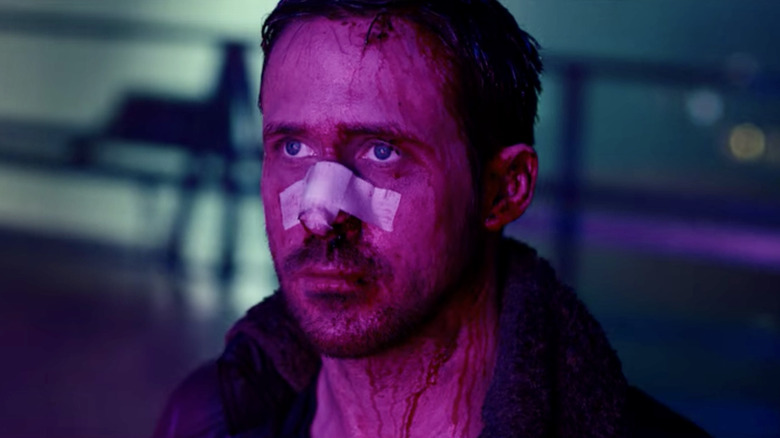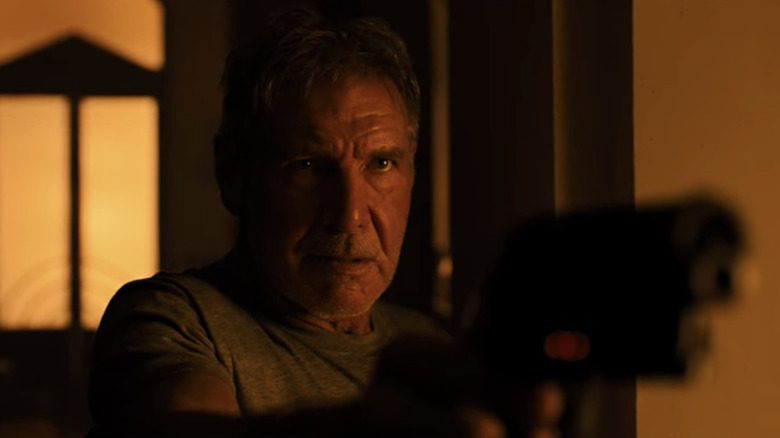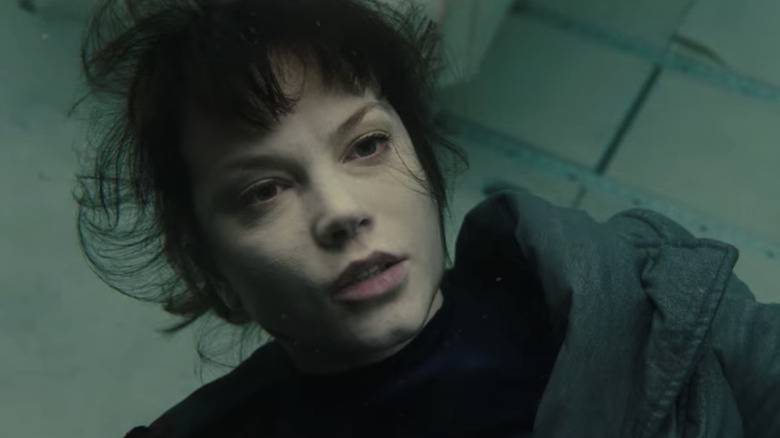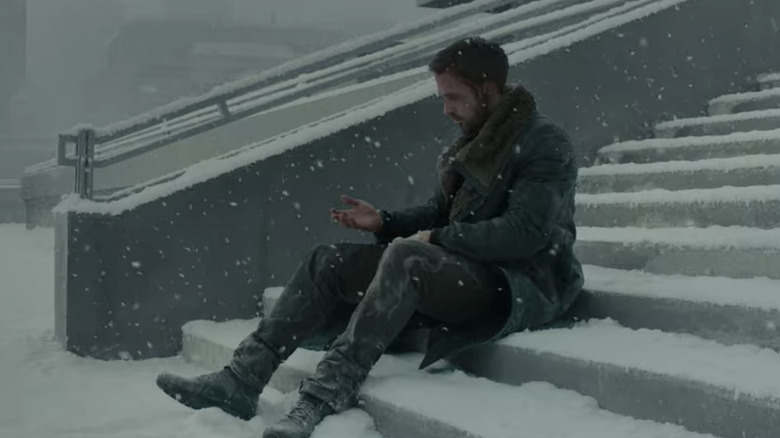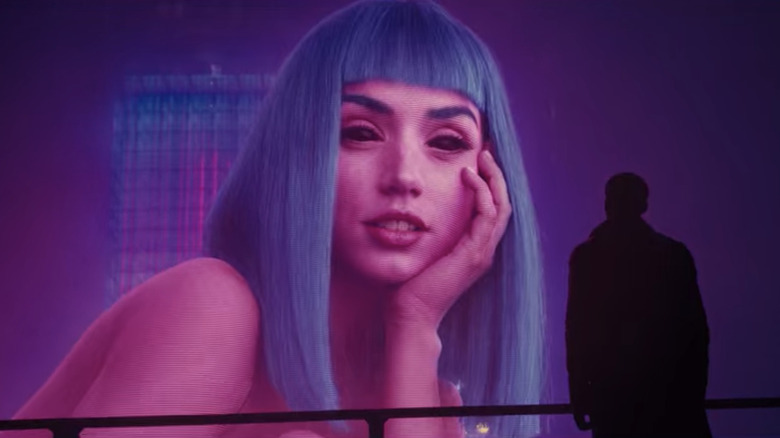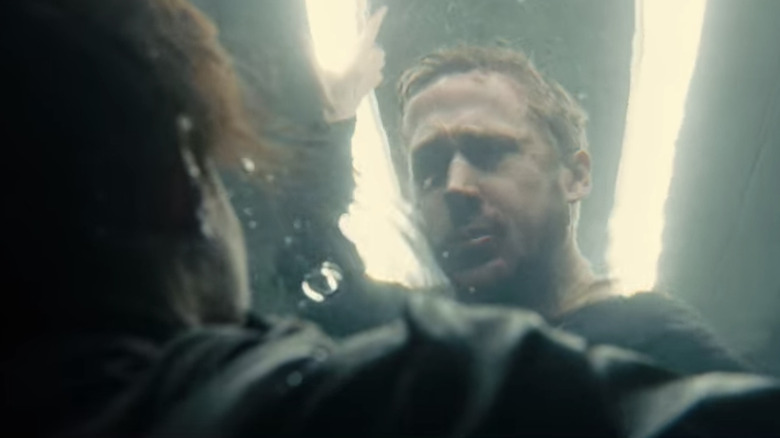Blade Runner 2049 Ending Explained: A Fresh Twist On The Old Chosen One Narrative
One of the most interesting things about "Blade Runner 2049" is its subversive ending. In the 2010s, after making a couple of top-notch thrillers — "Prisoners" and "Sicario" — director Denis Villeneuve entered a new sci-fi phase in his career with "Arrival" and "Blade Runner 2049." "Arrival" garnered eight Academy Award nominations, including Best Picture and Best Director for Villeneuve, whereas "Blade Runner 2049" earned accolades more in the technical categories. It was considered a box office disappointment, and Villeneuve later reflected that it could have ended his career (though of course, he'd survive to shoot another science-fiction epic, "Dune.")
Ridley Scott's original 1982 film, "Blade Runner," was not a smashing commercial or critical success in its day, either. However, its stature has grown considerably in the intervening years, to the point where it is now in the National Film Registry and was one of the titles chosen for the 10th-anniversary edition of the American Film Institute's list of the 100 greatest American movies of all time.
Villeneuve was faced with the task of delivering a sequel to a classic. He responded with a long, meditative film that became an instant classic for some and that seems destined to become a cult classic for others. Maybe in 2052, when they make "Blade Runner 2079," more people will rediscover this film ... but why wait?
If you're here, maybe you're already looking to rediscover "Blade Runner 2049," or maybe you've just seen it for the first time and are still digesting what you watched. The film's ending upends what Ryan Gosling's protagonist, K, and the audience thinks about him. Here, we'll be examining that ending with spoilers.
Viva Las Harrison
With stunning production design by Dennis Gassner and Oscar-winning cinematography by Roger Deakins, "Blade Runner 2049" is a visual feast. It delivers all the neon you would expect from a "Blade Runner" sequel, yet it also takes viewers through the orange haze of a desert landscape into an abandoned Las Vegas, which looks like it was overrun by a sandstorm. That's where we finally catch up with Harrison Ford's character, Rick Deckard, from the original "Blade Runner" movie.
In "Blade Runner 2049," Deckard doesn't enter the picture until the last hour, and when he does, he and K are bound by the laws of superhero/blade runner first meetings to fight. They do it in a casino lounge against the backdrop of glitchy Elvis Presley and go-go dancer holograms. The film's Hans Zimmer and Benjamin Wallfisch score gives way to jukebox songs like "Suspicious Minds," "Can't Help Falling in Love with You," and eventually, Frank Sinatra's "One for My Baby (and One More for the Road)."
After Deckard gets tired of punching K, they sit down together at the bar for a drink. At this point, K is still operating under the assumption that he is Deckard's son, the first child ever born of a replicant (Rachael, Sean Young's character from the original "Blade Runner"). Deckard refuses to accept the name K, so K introduces himself as "Joe," the name his digital companion, Joi (Ana de Armas), bestowed on him back in his lonely apartment.
It's a name that imports an average-Joe quality to him, as if he were just some guy caught up in forces he does not understand — which is exactly what he is. That's the thing about K/Joe: he's not as special as he thinks.
The Chosen Wannabe
Deckard explains that he abandoned his child with Rachael to an orphanage because they were being hunted. He didn't want to put a target on the child's back. "Sometimes, to love someone, you've got to be a stranger," he says. K had already visited the orphanage earlier, looking for old records there, and we've already seen, via flashback, a memory he had of himself as a boy (or so we think).
In that flashback, other children were chasing K to get at a wooden horse toy he had, but he was able to hide it in an unused furnace before they caught up with him. Finding this same toy in the furnace, years later, makes him realize that it's a real memory he's been carrying around in his head all this time, as opposed to just an implanted one that his artificial consciousness as a replicant holds. K comes to believe that he is more than just a replicant. He's the chosen one.
This is a time-honored trope that has popped up elsewhere in science-fiction and other genres, with "The Matrix" being one example that explicitly identifies its chosen one, Neo, as "The One." Another example would be the "Star Wars" franchise, where Obi-Wan Kenobi has been known to scream, "You were the chosen one!" at Anakin Skywalker.
Up to this point, what we know of K in "Blade Runner" slots right into that familiar old Chosen One narrative. It's not long, however, before the replicant enforcer, Luv (Sylvia Hoeks), shows up in Vegas, where she kidnaps Deckard and stomps on the device containing Joi, destroying K's imaginary girlfriend and leaving him for dead. The truth is, K is the Chosen Wannabe, and he's about to come to terms with that.
Ready to Meet His Fate
With Luv and Deckard gone, K gets picked up by a group of replicant revolutionaries, which includes Mariette (Mackenzie Davis), the prostitute Joi used for her body double when she and K were making love. The head of the group, Freysa (Hiam Abbass), was there when Rachael's miracle baby was born, and it turns out the child was a girl. K realizes that Ana (Carla Juri), a doctor and memory designer for replicants he met before, is Deckard's daughter. She illegally implanted her own real memories in him.
It's official: he's not the chosen one, after all. With pity, Freysa says to him, "You imagined it was you... We all wish it was us."
Deakins and Gassner also collaborated on the James Bond film, "Skyfall," and in "Blade Runner 2049," they brought to bear the same creative synergy to fashion a series of eye-catching tableaus: not just the nighttime views of a futuristic L.A. or the dusty daytime vistas of Vegas in ruins, but also, some stylishly lit interiors in the Wallace Corporation. It's an industrial temple with floors surrounded by water, like islands. The walls shimmer with watery reflections.
This is where Deckard confronts a carbon copy of Rachael, a replicant of a replicant, the handiwork of the blind technologist, Niander Wallace (Jared Leto). When Deckard refuses to give up information about his child's last-known whereabouts, Wallace sends him off with Luv, with the understanding that torture awaits him off-world.
K, however, intercepts them in his flying car, forcing them to crash-land on a seawall, where K and Luv subsequently fight to the death. He drowns her, but not before she stabs him and gives him the kiss of death, declaring herself "the best one."
The Big Bright Lie
Luv is her own Chosen Wannabe, whose dying view of K underwater is "through a glass, darkly," per the Bible and Philip K. Dick, the author of both "A Scanner Darkly" and "Do Androids Dream of Electric Sheep?" (The latter of which was the basis for "Blade Runner.")
Since it will look like Deckard has perished in the crash, K is able to defy both Wallace's will (torture Deckard for information) and that of the replicant revolutionaries (kill Deckard to protect the child). He takes Deckard to be reunited with his daughter. Outside Ana's lab, K lies down on the snowy steps, succumbing to his wounds, ready to meet his melancholy fate.
"Blade Runner 2049" has a bittersweet ending. K's fate is ultimately a sad yet noble one. He's not the chosen one, but he still got to play the hero. In so many ways, he symbolizes the egocentric inner child in all of us, who wants to believe they are so much more than they really are sometimes.
We grow up in the light of Hollywood, our heads filled with movie images, thinking anything is possible. The silver screen promises that dreams — even android ones filled with electric sheep — do come true for all of us. For K, however, the dream and the promise of self-actualization as some messianic replicant child do not come true.
Joi was always there to support him, telling him what he wanted to hear, but after she's gone and he's lost his Joi (the joy of the lies we tell ourselves about ourselves), he sees her again in a different context. This time, she's a giant pink hologram with blue hair. In the rain, she greets him, "Hello, handsome," but her eyes are black and soulless.
Through a Glass Darkly
When Joi points right at K and says, "You look like a good Joe," it's now a reminder that she's a hollow construct who peddles the same line to all lonely guys, mediocre Chosen Wannabes.
People identify "Blade Runner" with the neon of Hong Kong or Tokyo, cities far from American shores. Yet this is a movie that, on one level, appeals to the spirit of the American dreamer, that wounded idealist who believes they're the hero of their own story and it all revolves around them ... only to find that the world has different plans in store for them.
Beyond the requisite continuation of the first movie's story, it's no coincidence, perhaps, that "Blade Runner 2049," is set in L.A., a place that offers up no shortage of movie mirages, evanescent holograms of humanity that land like tears in the rain. It's a movie that speaks to an entire generation of millennials and movie-lovers, looking for their moment to shine online or wherever. The world is flooded with all this glittering content ("Everything You Want," like Joi), and at a certain point, it drowns us all out, leaving our faces and perhaps our very selves blurred and indistinct, dark-eyed, like K's.
In such a vast, bleak, overstimulated world, the best one can hope for, maybe, is to do something selfless and find a separate peace that way. K does that when he reunites Deckard and his daughter. Our final image of him is in a setting where the classic rain of "Blade Runner" has frozen over into snow. He's left his mark on them and their lives, just as the movie has with ours.
